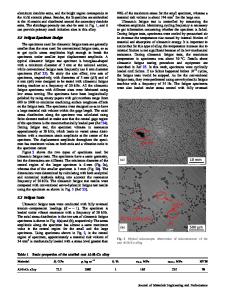Fatigue crack initiation and strain-controlled fatigue of some high strength low alloy steels
- PDF / 4,459,487 Bytes
- 14 Pages / 594 x 774 pts Page_size
- 44 Downloads / 394 Views
I.
INTRODUCTION
THE main
objectives of the present study were to investigate initiation of fatigue cracks and growth of microcracks in some V and Nb-alloyed high strength low alloy steels, including conventional and dual phase microstructures. The cyclic mechanical properties were also determined. In high cycle fatigue tests, it is generally accepted that the greatest proportion of the fatigue life is spent in initiating and growing microcracks rather than in propagating macrocracks. Therefore, this portion of the fatigue life is of great engineering importance. The literature on fatigue crack initiation and growth of microcracks in metals has been reviewed recently. 1.2 Kung and Fine, 3 by a statistical analysis of fatigue crack initiation probability near inclusions vs inclusion size in 2024-T4 aluminum alloys, found that the probability of fatigue crack initiation dropped off rapidly as the inclusion size decreased below approximately 7 /zm. This was attributed to the probability for the impingement of a slip line on an inclusion decreasing with decrease in inclusion size. Grain boundaries often slow down or stop fatigue microcracks, because the slip systems are discontinuous across grain boundaries. 3'4 In some cases, though, grain boundaries act as fatigue crack initiation sites and paths for fast microcrack and macrocrack growth, such as in as-quenched medium carbon steels) Formation of persistent or prominent slip bands (PSBs) is recognized as a general phenomenon leading to fatigue crack initiation. In EC.C. metals such as single crystals of Cu, 6-1~Ni, 6 and A1,11 the structure of PSBs is known to be ladder 6 or wall-like, 8 consisting of primary edge dislocation dipole (or multipole) arrangements created by continuous annihilation of opposite sign screw dislocations by crossslip during cyclic loading. Therefore, a main factor facilitating the development of PSBs is the ease of cross-slip ( i . e . , low stacking fault energy). Because of the low mobility of screw dislocations and the difficulty of cross-slipping in the B.C.C. structure, formation of PSBs is not considered to be a general feature in Y.H. KIM is Senior Research Scientist with General Dynamics, Ft. Worth, TX 76101. M . E . FINE is W.P. Murphy Professor of Materials Science and Engineering, Northwestern University, Evanston, IL 60201. Manuscript submitted February 23, 1981. METALLURGICAL TRANSACTIONS A
pure B.C.C. metals, but may occur in impure metals and at low strain rates, t2 Mughrabi e t a112 indicated that the cyclic deformation in pure B.C.C. metals produces an open cell structure 13rather than a ladder-like structure 6 or a cylindrical structure. ~4 They claimed that fatigue crack initiation is, thus, expected to be due to other than PSB formation in pure B.C.C. metals. However, interstitials slow down edge dislocations so their velocity is more nearly like that for screws, and PSBs are thought to occur in impure iron. Thus, the role of PSBs in fatigue crack initiation may be important in low C steels. Two Nb-bearing and two V-bea
Data Loading...











